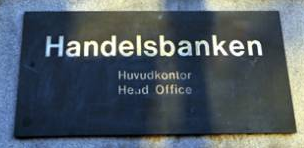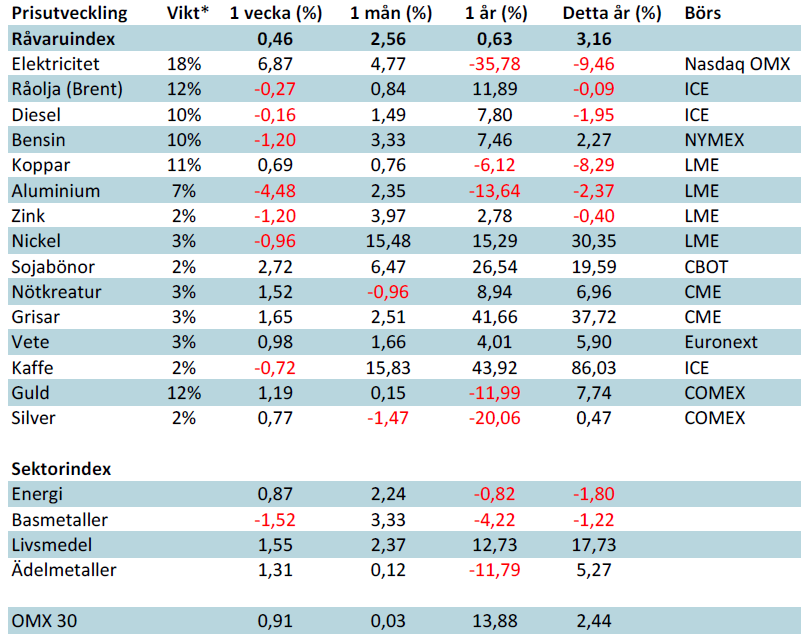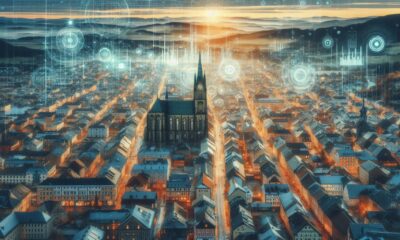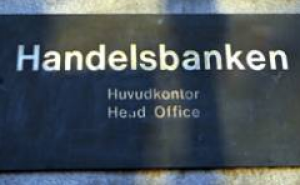Analys
SHB Råvarubrevet 30 april 2014

Råvaror allmänt: Kina tynger, Europa ser ljuset
 Kinesisk data var en rejäl “bang” under första kvartalet. Sämre än väntat på alla håll och kanter. Överraskningsindex har fallit till lägsta nivåerna sedan Lehman-krisen. Ekonomers förväntningar har nu justerats ner och framöver borde data inte vara negativ överraskning även om aktiviteten inte ser ut att förbättras nämnvärt. I Europa fortsätter däremot data att beskriva en ljusare framtid. Låga räntekostnader efter Draghi´s ”whatever it takes” kommentar i juli 2012 sipprar igenom systemet till ökad slutkonsumtion. Vinterns negativa överraskningar i USA, härledda till det smällkalla vädret har dragit förbi. Vi fortsätter dock att tro att 2013 års nedskalning av QE kommer tynga ekonomin.
Kinesisk data var en rejäl “bang” under första kvartalet. Sämre än väntat på alla håll och kanter. Överraskningsindex har fallit till lägsta nivåerna sedan Lehman-krisen. Ekonomers förväntningar har nu justerats ner och framöver borde data inte vara negativ överraskning även om aktiviteten inte ser ut att förbättras nämnvärt. I Europa fortsätter däremot data att beskriva en ljusare framtid. Låga räntekostnader efter Draghi´s ”whatever it takes” kommentar i juli 2012 sipprar igenom systemet till ökad slutkonsumtion. Vinterns negativa överraskningar i USA, härledda till det smällkalla vädret har dragit förbi. Vi fortsätter dock att tro att 2013 års nedskalning av QE kommer tynga ekonomin.
Basmetaller: Byter till neutral vy på nickel
Vi har länge haft nickel som vår favoritmetall då den handlats på låga nivåer där 40 % av gruvorna gick back. Den 1:a april skickade vi ut ett tradingcase där vi intensifierade vår starka tro på stigande nickelpris efter att Indonesiens exportförbud på nickelmalm från den 12e januari såg ut att vara robust samtidigt som den eskalerande krisen mellan Ryssland och Ukraina fick finansmarknaden att handla upp nickel på oror för att Ryssland skulle införa exportrestriktioner på nickel som en kontramanöver på eventuella handelssanktioner från Väst.
Sedan den 1a april har vårt certifikat Long Nickel H stigit 15 % och Bull nickel med 29 %. I vårt case hade vi en tro att nickel skulle stiga stadigt under året i takt med att Kina betar av sina lager av den malm som man nu inte längre kan importera från Indonesien. I och med situationen kring Ryssland har hela prisrörelsen kommit på kort tid och därför kliver vi av tåget och är nöjda med vinsten. Vi tror inte att priset har så stor nedsida härifrån men risk/award på de här nivåerna är i dagsläget inte lockande i våra ögon.
Ädelmetaller: Ikväll är det dags!
Ikväll är det dags för Federal Reserves tredje räntemöte för året, och därmed det vi ansett vara de viktigaste för guldprisutvecklingen framöver. Fed har gått från att bedömas vara hökaktiga till nu mer mjuka i sin syn på räntepolitiken och det har skapat en hel del rörelser på räntemarknaden. Guldet har dock spenderat hela april månad i en väldigt tight range, och vi stänger månaden på exakt samma nivå som vi öppnade den, på 1290 USD per uns.
Det gör att vi anser att Fed ikväll måste säga något eller göra något som överraskar marknaden ganska rejält för att det ska orsaka stora prisrörelser på kort sikt. Det ser dock ut som att kvällens besked knappast blir någon kioskvältare, av alla ekonomer som prognosticerar QE tror samtliga på en takt om 45 miljarder USD per månad, en minskning om 10 miljarder, vilket närmast garanterat blir det besked som lämnas. Marknadsreaktionerna kommer istället att skapas av det finstilta i pressmeddelandet, och vi återkommer med en kort sammanfattning av reaktioner och vyer på fredag. Vi bibehåller vår positiva syn på guldet fortsatt, men uppdaterar den om ny information framkommer i kvällens besked.
Energi: Ukraina och Libyen ger stöd till oljepriset
Oljan handlas fortsatt på höga nivåer efter att tonläget mellan USA och Ryssland höjts där Nato manade till rysk truppreträtt samtidigt som Libyska parlamentet stormades av beväpnade män och tvingat parlamentets ledamöter att avbryta en omröstning om premiärministerposten. Libyen är utöver utvecklingen kring Ukraina en avgörande faktor för utvecklingen på kort sikt. Igår lyfte rebeller blockaden vid Zweitinahamnen, en av de fyra terminaler som regeringen förlorade kontrollen vid i juli förra året och en av de två som enligt överenskommelsen från 6 april skulle återupptas. Denna blockad beräknas ha kostat Libyen uppemot 8 miljarder dollar om vi ser till produktionsbortfallet om närmare 1.15 miljoner fat per dag (från 1.4 miljoner till 250,000 fat i mars 2014). Libyen som sitter på en stor reserv kan inte annat än betraktas som ett osäkert kort och motiverar fortsatt en riskpremie tills dess att regeringen återfår kontrollen över landets oljeproduktion. En faktor som talar för ett fallande oljepris är amerikanska lagersiffror som förväntas stiga med ytterligare 1.9 miljoner fat i dagens rapport vilket i kombination med dagens penningpolitiska besked från Fed ligger närmast till hands att snegla på.
Livsmedel: Kaffepriset på nya höjder
Terminspriserna på Arabicakaffe steg i förra veckan till nya höjder igen och nådde årshögsta efter att den ansedda schweiziska kaffehandlaren, Volcafe justerade ned sitt estimat för årets skörd i Brasilien till 18 procent lägre än föregående period. Världens största kaffeproducent som lyckats redovisa flera år av rekordskördar, riskerar även ett produktionsbortfall uppemot 20 procent för nästkommande år. Skörden är påbörjad i delar av landet och kaffehandlare runt om i världen är nu eniga om att årets första två månader med uteblivet regn inte kommer kunna kompenseras av den nederbörd landet fick under mars månad. Sent i fredags eftermiddag föll priserna igen under 2 dollar/Ib efter nya vinsthemtagningar för att stiga tillbaka igen under gårdagen. Vi tror fortsatt på en instabil marknad i några månader till – skörden är endast i initialfasen, där nya estimat och väderrapporter kan driva kaffepriserna till nya höjder.
Handelsbankens råvaruindex (USD)

*Uppdaterade vikter från 29 november 2013
Handelsbankens råvaruindex består av de underliggande indexen för respektive råvara. Vikterna är bestämda till hälften från värdet av nordisk produktion (globala produktionen för sektorindex) och till hälften från likviditeten i terminskontrakten.
[box]SHB Råvarubrevet är producerat av Handelsbanken och publiceras i samarbete och med tillstånd på Råvarumarknaden.se[/box]
Ansvarsbegränsning
Detta material är producerat av Svenska Handelsbanken AB (publ) i fortsättningen kallad Handelsbanken. De som arbetar med innehållet är inte analytiker och materialet är inte oberoende investeringsanalys. Innehållet är uteslutande avsett för kunder i Sverige. Syftet är att ge en allmän information till Handelsbankens kunder och utgör inte ett personligt investeringsråd eller en personlig rekommendation. Informationen ska inte ensamt utgöra underlag för investeringsbeslut. Kunder bör inhämta råd från sina rådgivare och basera sina investeringsbeslut utifrån egen erfarenhet.
Informationen i materialet kan ändras och också avvika från de åsikter som uttrycks i oberoende investeringsanalyser från Handelsbanken. Informationen grundar sig på allmänt tillgänglig information och är hämtad från källor som bedöms som tillförlitliga, men riktigheten kan inte garanteras och informationen kan vara ofullständig eller nedkortad. Ingen del av förslaget får reproduceras eller distribueras till någon annan person utan att Handelsbanken dessförinnan lämnat sitt skriftliga medgivande. Handelsbanken ansvarar inte för att materialet används på ett sätt som strider mot förbudet mot vidarebefordran eller offentliggörs i strid med bankens regler.
Analys
Tightening fundamentals – bullish inventories from DOE

The latest weekly report from the US DOE showed a substantial drawdown across key petroleum categories, adding more upside potential to the fundamental picture.

Commercial crude inventories (excl. SPR) fell by 5.8 million barrels, bringing total inventories down to 415.1 million barrels. Now sitting 11% below the five-year seasonal norm and placed in the lowest 2015-2022 range (see picture below).
Product inventories also tightened further last week. Gasoline inventories declined by 2.1 million barrels, with reductions seen in both finished gasoline and blending components. Current gasoline levels are about 3% below the five-year average for this time of year.
Among products, the most notable move came in diesel, where inventories dropped by almost 4.1 million barrels, deepening the deficit to around 20% below seasonal norms – continuing to underscore the persistent supply tightness in diesel markets.
The only area of inventory growth was in propane/propylene, which posted a significant 5.1-million-barrel build and now stands 9% above the five-year average.
Total commercial petroleum inventories (crude plus refined products) declined by 4.2 million barrels on the week, reinforcing the overall tightening of US crude and products.


Analys
Bombs to ”ceasefire” in hours – Brent below $70

A classic case of “buy the rumor, sell the news” played out in oil markets, as Brent crude has dropped sharply – down nearly USD 10 per barrel since yesterday evening – following Iran’s retaliatory strike on a U.S. air base in Qatar. The immediate reaction was: “That was it?” The strike followed a carefully calibrated, non-escalatory playbook, avoiding direct threats to energy infrastructure or disruption of shipping through the Strait of Hormuz – thus calming worst-case fears.

After Monday morning’s sharp spike to USD 81.4 per barrel, triggered by the U.S. bombing of Iranian nuclear facilities, oil prices drifted sideways in anticipation of a potential Iranian response. That response came with advance warning and caused limited physical damage. Early this morning, both the U.S. President and Iranian state media announced a ceasefire, effectively placing a lid on the immediate conflict risk – at least for now.
As a result, Brent crude has now fallen by a total of USD 12 from Monday’s peak, currently trading around USD 69 per barrel.
Looking beyond geopolitics, the market will now shift its focus to the upcoming OPEC+ meeting in early July. Saudi Arabia’s decision to increase output earlier this year – despite falling prices – has drawn renewed attention considering recent developments. Some suggest this was a response to U.S. pressure to offset potential Iranian supply losses.
However, consensus is that the move was driven more by internal OPEC+ dynamics. After years of curbing production to support prices, Riyadh had grown frustrated with quota-busting by several members (notably Kazakhstan). With Saudi Arabia cutting up to 2 million barrels per day – roughly 2% of global supply – returns were diminishing, and the risk of losing market share was rising. The production increase is widely seen as an effort to reassert leadership and restore discipline within the group.
That said, the FT recently stated that, the Saudis remain wary of past missteps. In 2018, Riyadh ramped up output at Trump’s request ahead of Iran sanctions, only to see prices collapse when the U.S. granted broad waivers – triggering oversupply. Officials have reportedly made it clear they don’t intend to repeat that mistake.
The recent visit by President Trump to Saudi Arabia, which included agreements on AI, defense, and nuclear cooperation, suggests a broader strategic alignment. This has fueled speculation about a quiet “pump-for-politics” deal behind recent production moves.
Looking ahead, oil prices have now retraced the entire rally sparked by the June 13 Israel–Iran escalation. This retreat provides more political and policy space for both the U.S. and Saudi Arabia. Specifically, it makes it easier for Riyadh to scale back its three recent production hikes of 411,000 barrels each, potentially returning to more moderate increases of 137,000 barrels for August and September.
In short: with no major loss of Iranian supply to the market, OPEC+ – led by Saudi Arabia – no longer needs to compensate for a disruption that hasn’t materialized, especially not to please the U.S. at the cost of its own market strategy. As the Saudis themselves have signaled, they are unlikely to repeat previous mistakes.
Conclusion: With Brent now in the high USD 60s, buying oil looks fundamentally justified. The geopolitical premium has deflated, but tensions between Israel and Iran remain unresolved – and the risk of missteps and renewed escalation still lingers. In fact, even this morning, reports have emerged of renewed missile fire despite the declared “truce.” The path forward may be calmer – but it is far from stable.
Analys
A muted price reaction. Market looks relaxed, but it is still on edge waiting for what Iran will do

Brent crossed the 80-line this morning but quickly fell back assigning limited probability for Iran choosing to close the Strait of Hormuz. Brent traded in a range of USD 70.56 – 79.04/b last week as the market fluctuated between ”Iran wants a deal” and ”US is about to attack Iran”. At the end of the week though, Donald Trump managed to convince markets (and probably also Iran) that he would make a decision within two weeks. I.e. no imminent attack. Previously when when he has talked about ”making a decision within two weeks” he has often ended up doing nothing in the end. The oil market relaxed as a result and the week ended at USD 77.01/b which is just USD 6/b above the year to date average of USD 71/b.

Brent jumped to USD 81.4/b this morning, the highest since mid-January, but then quickly fell back to a current price of USD 78.2/b which is only up 1.5% versus the close on Friday. As such the market is pricing a fairly low probability that Iran will actually close the Strait of Hormuz. Probably because it will hurt Iranian oil exports as well as the global oil market.
It was however all smoke and mirrors. Deception. The US attacked Iran on Saturday. The attack involved 125 warplanes, submarines and surface warships and 14 bunker buster bombs were dropped on Iranian nuclear sites including Fordow, Natanz and Isfahan. In response the Iranian Parliament voted in support of closing the Strait of Hormuz where some 17 mb of crude and products is transported to the global market every day plus significant volumes of LNG. This is however merely an advise to the Supreme leader Ayatollah Ali Khamenei and the Supreme National Security Council which sits with the final and actual decision.
No supply of oil is lost yet. It is about the risk of Iran closing the Strait of Hormuz or not. So far not a single drop of oil supply has been lost to the global market. The price at the moment is all about the assessed risk of loss of supply. Will Iran choose to choke of the Strait of Hormuz or not? That is the big question. It would be painful for US consumers, for Donald Trump’s voter base, for the global economy but also for Iran and its population which relies on oil exports and income from selling oil out of that Strait as well. As such it is not a no-brainer choice for Iran to close the Strait for oil exports. And looking at the il price this morning it is clear that the oil market doesn’t assign a very high probability of it happening. It is however probably well within the capability of Iran to close the Strait off with rockets, mines, air-drones and possibly sea-drones. Just look at how Ukraine has been able to control and damage the Russian Black Sea fleet.
What to do about the highly enriched uranium which has gone missing? While the US and Israel can celebrate their destruction of Iranian nuclear facilities they are also scratching their heads over what to do with the lost Iranian nuclear material. Iran had 408 kg of highly enriched uranium (IAEA). Almost weapons grade. Enough for some 10 nuclear warheads. It seems to have been transported out of Fordow before the attack this weekend.
The market is still on edge. USD 80-something/b seems sensible while we wait. The oil market reaction to this weekend’s events is very muted so far. The market is still on edge awaiting what Iran will do. Because Iran will do something. But what and when? An oil price of 80-something seems like a sensible level until something do happen.
-

 Nyheter3 veckor sedan
Nyheter3 veckor sedanStor uppsida i Lappland Guldprospekterings aktie enligt analys
-

 Nyheter4 veckor sedan
Nyheter4 veckor sedanBrookfield ska bygga ett AI-datacenter på hela 750 MW i Strängnäs
-

 Nyheter3 veckor sedan
Nyheter3 veckor sedanSilverpriset släpar efter guldets utveckling, har mer uppsida
-

 Nyheter4 veckor sedan
Nyheter4 veckor sedanTradingfirman XTX Markets bygger datacenter i finska Kajana för 1 miljard euro
-

 Nyheter2 veckor sedan
Nyheter2 veckor sedanUppgången i oljepriset planade ut under helgen
-

 Nyheter2 veckor sedan
Nyheter2 veckor sedanLåga elpriser i sommar – men mellersta Sverige får en ökning
-

 Analys2 veckor sedan
Analys2 veckor sedanVery relaxed at USD 75/b. Risk barometer will likely fluctuate to higher levels with Brent into the 80ies or higher coming 2-3 weeks
-

 Nyheter1 vecka sedan
Nyheter1 vecka sedanMahvie Minerals växlar spår – satsar fullt ut på guld











